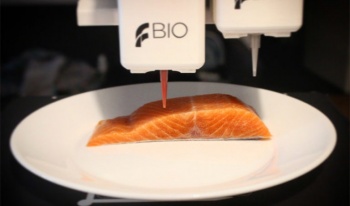
Following the many developments in the space of 3D printed meat, it’s the turn of fish! A team of Danish students has developed a project called Legendary Vish that aims to offer a vegan alternative to salmon in Europe. They have chosen a 3D printed fish from plants, to be eaten raw like sashimi or sushi. Their technology would enable them to reproduce the appearance and texture of salmon and above all to obtain a correct structure, containing enough protein to be a viable alternative. The team is also expected to propose tuna. So when will we see 3D printed fish on our plates?
According to the World Health Organization, fish consumption has been increasing annually by 3.6% since the 1960s. Although these figures are not as high as those for meat consumption, we still need to keep a close watch because our rivers and oceans are over-exploited, disrupting an important ecosystem. Advances in aquaculture, i.e. the farming and collection of fish, molluscs and aquatic plants, are also coming into play, with real consequences for our environment (pollution of the oceans, wastage of food by fish, chemical treatments used, etc.). Faced with this reality, Robin Sisma, Theresa Rothenbücher and Hakan Gürbüz decided to embark on an innovative project and propose a greener alternative.
By turning to 3D printing, the three young partners are able to recreate the texture, appearance and taste of fish. They would use Felixprinters 3D printers and a priori bioprinters on which they could extrude several inks at the same time. For now, they are focusing on producing salmon from mushroom and pea proteins, starch and agar. They also say that avocado and nut oil should be added, both of which are rich in omega-3 fatty acids. Robin Sisma, CEO of Lengendary Vish, explains: “One of the most important things for us is to recreate the nutritional value of fish, especially the Omega 3 fatty acids. There are many fatty acids based on plants or algae, and we are currently testing several ingredients to find the perfect solution.“
Beyond the nutritional aspect, the team is particularly interested in the taste of 3D printed fish: it explains that it is working with a company specialising in flavours and fragrances in order to get as close as possible to the initial taste. It is thanks to 3D printing technologies that Lengendary Vish can obtain a satisfactory fish structure. Robin Sisma continues: “Thanks to our printing process, we obtain the complex appearance of our salmon fillets, which show the realistic distribution of orange/red meat tissue and white connective tissue.”

The 3D printed fish | Credits: Lengendary Vish
The Lengendary Vish team still faces some challenges: the first one mainly concerns the volume of production today. They explain that they are looking to produce more fish and meet a wider demand. The second challenge is related to regulations: how to ensure that 3D printed salmon meets food standards? 3D printing is still a fairly young technology in the food sector and many certifications have yet to be defined. We will have to be patient since the first products will not be available until 2022. You can find more information HERE.
Would you try 3D printed fish? Let us know in a comment below or on our Facebook and Twitter pages! And remember to sign up for our free weekly Newsletter, to get all the latest news in 3D printing sent straight to your inbox!


